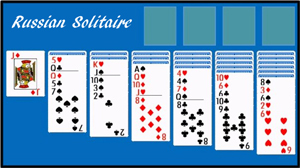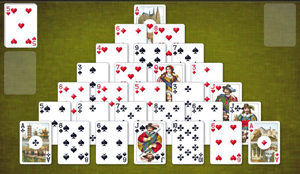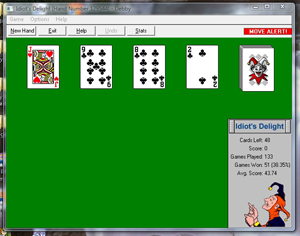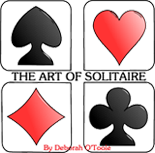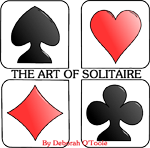Solitaire Links
- 123 Free Solitaire
- AARP Online Solitaire
- Hardwood Solitaire
- Hoyle Card Games
- Idiot's Delight
- Loch Ness Solitaire
- Midnight Sunitaire
- Mike's Cards
- Online Solitaire
- Online Solitaire (2)
- Pretty Good Solitaire
- Solitaire Card Games
- Solitaire Card Games (2)
- Solitaire City
- Solitaire Online
- Solitaire Paradise
- Solitaire Plus!
- Solitaired
- SolSuite
- Spider Solitaire
- World of Solitaire

Please Note: Downloading solitaire programs from online vendors is done so at the users own risk. It is advised to verify the system requirements of your computer or other device before downloading.
Resources
Favorite Games
- Australian Patience
- Double Klondike
- Golf
- Idiot's Delight
- Klondike
- Klondike By Threes
- Precedence
- Pyramid
- Russian Solitaire
- Ukrainian Solitaire
Click on images below to view larger sizes in a new window.
BRIEF HISTORY OF SOLITAIRE
Solitaire has a long and varied history. Originally called "Patience," the game is still referred to as such in many parts of Europe. Some historians note that solitaire games were first played with tarot cards, leading them to also believe solitaire probably came before the multi-player card games that were once traditionally played.
During the fourteenth century, playing cards were introduced in Italy and shortly thereafter became popular in Northern Europe. The first-known rules for the game of solitaire were apparently recorded in the era of Napoleon, who supposedly played patience in his spare time. Also during this period in history, Tolstoy enjoyed solitaire and wrote briefly about the game in his novel, War and Peace. Early origins of solitaire seemed to generate from the French. One of their most popular games was called La Belle Lucie, which is still played today and is available on several solitaire computer programs.
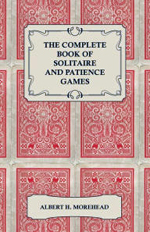 Several card games were invented during the sixteenth century, when it was
believed the ace became a high card instead of low in the course of various
games. It is also felt that solitaire was created in this time period,
although mention of the game did not appear in print until the late
nineteenth century. After the Civil War, Lady Adelaide Cadogan is said to
have written the first rule book for patience and solitaire games (Lady
Cadogan's Illustrated Games of Solitaire or Patience). Shortly
thereafter several other people wrote books about the game of solitaire,
including E.D. Chaney (Patience); and Annie B. Henshaw (Amusements
for Invalids). Years later, Dick & Fitzgerald published
Dickie's Games
of Patience and another named Henry Jones wrote "Patience Games" to be
followed by
Mary Whitmore Jones (no relation), who penned a series of
solitaire books at the turn of the twentieth century. One of the most
comprehensive and widely accepted solitaire rule books was written by Albert
Morehead and Geoffrey Mott-Smith and contains rules for more than two
hundred solitaire variations.
Several card games were invented during the sixteenth century, when it was
believed the ace became a high card instead of low in the course of various
games. It is also felt that solitaire was created in this time period,
although mention of the game did not appear in print until the late
nineteenth century. After the Civil War, Lady Adelaide Cadogan is said to
have written the first rule book for patience and solitaire games (Lady
Cadogan's Illustrated Games of Solitaire or Patience). Shortly
thereafter several other people wrote books about the game of solitaire,
including E.D. Chaney (Patience); and Annie B. Henshaw (Amusements
for Invalids). Years later, Dick & Fitzgerald published
Dickie's Games
of Patience and another named Henry Jones wrote "Patience Games" to be
followed by
Mary Whitmore Jones (no relation), who penned a series of
solitaire books at the turn of the twentieth century. One of the most
comprehensive and widely accepted solitaire rule books was written by Albert
Morehead and Geoffrey Mott-Smith and contains rules for more than two
hundred solitaire variations.
Bill Beers was a noted solitaire game inventor. He created Cribbage Solitaire while he was a patient at a mental hospital. However, perhaps the most commonly known form of solitaire (called either Klondike or Canfield), is said to have been devised by a casino owner named Mr. Canfield in Saratoga.
One deck of cards is used, laid out in four piles (foundations) and seven columns also known as the tableau. The foundations have to be built up in card suit from Ace to King (ex: a 2 can only be played on an ace). The tableau is built down in alternating colors (ex: 10 can be played only on a Jack). The top card of each pile is available for play on another tableau column, or the foundations. A packed sequence or any portions of it can be moved to another tableau column. Empty spaces in the seven-column layout can only be filled with a King or a King-sequence. The stock pile contains the remaining cards in the deck and can be turned out three at a time or one at a time, depending on individual preference. They are meant to be played to the tableau or the foundations wherever appropriate. The waste pile is for cards that cannot be played on either the tableau or foundations, and can be turned over and re-used in the game. The object of the game is to move all cards to the foundations in suit order.
There have been many variations of the original solitaire game over the years. Today, there are more than one thousand different solitaire alternatives. With the advent of computer solitaire, FreeCell and Spider-type games have become increasingly popular.
Russian Solitaire is one of the more difficult solitaire variations to win, although it has become a favorite of mine in recent years. The object of the game is to move all the cards to the foundations, but the game starts with four foundations built up in suit from Ace to King, with seven tableau piles set out below the foundations. Cards can be moved regardless of any sequence, and empty spaces can only be filled by Kings or a King-sequence. At the beginning of the game, one card is dealt to the first tableau pile, two the second pile, three to the third, and so on. The top card always remains face-up, and the additional four face cards are dealt to the other piles. Any card that is face-up in the tableau can be built on another, with the cards covering it moved as well. When a card face-down is uncovered, it is automatically turned face-up and available for play.
Russian Solitaire is a variation of Yukon. However, it is more challenging as the tableau is built down in the same suit rather than by alternate color. Similar games include Ace of Hearts, Alaska, Aunt Mary, Australian Patience, Cornelius, Darwin, Double Russian, Geoffrey, Griffon, Mississippi, Outback, Queenie, Raw Prawn, Russian Cell, Russian Point, Triple Russian, Ukrainian Solitaire, Yukon, Yukon Kings, Yukon Spider, Yukon Two-Decks and Yukon Three-Decks.
Another fun and somewhat easier solitaire-style game is Pyramid. The object of the game is to discard all cards in pairs totaling thirteen regardless of suit. Valid pairs for use in the game are:
- Ace and Queen (13)
- Two and Jack (13)
- Three and Ten (13)
- Four and Nine (13)
- Five and Eight (13)
- Six and Seven (13)
Jacks are worth eleven points, while Queens equal twelve points. Kings are worth thirteen points and can be discarded singularly. Pairs can be made from the stock card and an exposed Pyramid cad, or two exposed Pyramid cards. The stock pile remains separate but can be matched with valid cards. Cards are dealt one at a time from the stock pile, and typically three deals are allowed before having to begin a new game. The layout of the Pyramid game is called such because the cards are positioned to resemble a pyramid, overlapping when necessary, and only uncovered cards can be matched with another to equal thirteen points.
Variations of the game include Cheops, Double Pyramid, Giza, Pharaohs, Pyramid Easy-Couple, Pyramid Golf, Pyramid By Seven, Pyramid's Stones and Triangle.
COMPUTER SOLITAIRE
I'm a bona-fide computer-solitaire fanatic. I didn't learn how to play the game until about 1997, but I've certainly been hooked ever since. Though I prefer the computer variety, I still like to play solitaire with a normal deck of cards when the mood strikes. I won't play online versions of solitaire with the web unknown. The game was called solitaire for a reason: to be played and enjoyed alone.
 My first experience with computer solitaire was with the standard "Klondike"
version issued on most computers running Windows. I was soon bored with it
and went looking for more. The first program I downloaded was
123 Free
Solitaire (an offshoot of
SolSuite), where I learned different variations of
the game. Little did I know at the time that there were hundreds more to
follow. After 123 Free Solitaire, I opted for the "paid" version of the
program, which turned out to be
SolSuite. Initially, there were more than
two hundred variations of solitaire within the computer program. Over the
years this has increased, of course, and now there are more than six
hundred games. There are also options to customize each game with background
choices, card backs and audio.
My first experience with computer solitaire was with the standard "Klondike"
version issued on most computers running Windows. I was soon bored with it
and went looking for more. The first program I downloaded was
123 Free
Solitaire (an offshoot of
SolSuite), where I learned different variations of
the game. Little did I know at the time that there were hundreds more to
follow. After 123 Free Solitaire, I opted for the "paid" version of the
program, which turned out to be
SolSuite. Initially, there were more than
two hundred variations of solitaire within the computer program. Over the
years this has increased, of course, and now there are more than six
hundred games. There are also options to customize each game with background
choices, card backs and audio.
SolSuite also offers MahJong Suite, a collection of more than 170 mahjong solitaire games. I was skeptical about mahjong at first, but decided to give it a whirl. There are literally millions of possible game combinations, with several tile selections (from classic to traditional and the bizarre). One of the features I particularly liked when I first started was the "suggest a move" option from the Game Menu. I wasn't sure what I was doing in the beginning, so the little hints helped me learn the game faster. I highly recommend MahJong Suite for hours of endless pleasure.
 Another collection I tried early on was
Hardwood Solitaire. This is also
another favorite, mainly because of the sound and visual effects. The
setting for the various games is medieval, and the music is dreamy and
almost mystic. In 2002,
Hardwood Solitaire was completely re-hauled and more
than one hundred new games were added. If possible, the visual effects are
even more stunning than before. The opening of the program depicts a
shimmering waterfall, and you can set other sound effects to preference.
Another collection I tried early on was
Hardwood Solitaire. This is also
another favorite, mainly because of the sound and visual effects. The
setting for the various games is medieval, and the music is dreamy and
almost mystic. In 2002,
Hardwood Solitaire was completely re-hauled and more
than one hundred new games were added. If possible, the visual effects are
even more stunning than before. The opening of the program depicts a
shimmering waterfall, and you can set other sound effects to preference.
Another well-done and large program is Goodsol Development's Pretty Good Solitaire. The assortment of more than nine hundred games and customizable features make it worth the price. Goodsol also offers several other programs, including Action Solitaire, FreeCell Plus, FreeCell Wizard, Goodsol Solitaire 101, Most Popular Solitaire, Pretty Good Mahjongg, Solitaire Wizard and Spider Wizard.
Pretty Good Mahjongg contains tile, solitaire and memory games but is more expensive than MahJong Suite from SolSuite. Make sure you like the games before buying Pretty Good Mahjongg. A trial download is available.
 If you like interaction, sound effects and superb graphics,
Hoyle Card Games is your best bet. This software not only includes
solitaire, but has other favorites such as
Crazy Eights,
Cribbage,
Gin
Rummy, Hearts,
Old Maid,
Pinochle,
Poker,
Spades,
Spite & Malice, and many
others. You can customize your "character" in the games, and select various
opponents who talk, make gestures and have personalities of their own.
Another favorite is
Hoyle Puzzle & Board Games, which includes
Backgammon,
Checkers,
Chess,
Go-Fish, a variation of
Yahtzee called "Yacht" and many more.
If you like interaction, sound effects and superb graphics,
Hoyle Card Games is your best bet. This software not only includes
solitaire, but has other favorites such as
Crazy Eights,
Cribbage,
Gin
Rummy, Hearts,
Old Maid,
Pinochle,
Poker,
Spades,
Spite & Malice, and many
others. You can customize your "character" in the games, and select various
opponents who talk, make gestures and have personalities of their own.
Another favorite is
Hoyle Puzzle & Board Games, which includes
Backgammon,
Checkers,
Chess,
Go-Fish, a variation of
Yahtzee called "Yacht" and many more.
Both Hoyle programs are highly recommended. However, if you ever need to contact Hoyle's customer service department don't hold your breath waiting for a response.
For a good game and a laugh, try Pete Wiseman's Solitaire City. The BVS Solitaire Collection is also a nice program of Russian-based solitaires that is easy to operate without any spectacular special effects, along with solitaires of German and French origins, and old-time favorites. However, BVS Solitaire offers very poor customer service. If you have an issue with the games or the program itself, good luck. POST-SCRIPT 12/02/16: Upon reading my remarks about BVS Solitaire in this specific article, the owner of the company sent me the activation code for the latest version of the program. I have to amend my opinion about their customer service at this point. I would say their concern for buyer satisfaction is above par, and very rare these days.
Single-game programs that remain tried and true although sometimes difficult to win are Chinese Solitaire (free, but also often included in the multi-game programs as well), and Midnight Sunitaire which can be had either as "shareware" or for free, depending on where you find it.
 Mike's Cards is also another personal favorite, not only because the program
is fun but because I happen to know the designer, Mike Sedore.
Mike's Cards is also another personal favorite, not only because the program
is fun but because I happen to know the designer, Mike Sedore.
Many of the aforementioned solitaire programs contain lush backgrounds, sound effects and selections of artistic card deck styles and backs. Some of the programs also have customizable features.
Out of all the solitaire variations I've tried and played continuously, the best multi-game program remains SolSuite. They update monthly with new games and features, and I find the yearly upgrade easy to swallow. It's well worth the price tag, and then some. To date, my preferred games include Double Klondike, Golf, King of Scotland, Klondike, Klondike By Threes, Precedence, Pyramid and all variations of Russian Solitaire.
Other good programs include Idiot's Delight (layout pictured above), Loch Ness Solitaire and Solitaire Plus!.
END NOTES
Finding time on your hands doesn't necessarily mean hitting the world wide web or plopping in front of the television. Instead, try your hand at a solitaire game and you will inevitably find yourself hooked. The game, in whatever form you choose to play it, requires skill and concentrated thought process in most cases and will most likely leave you coming back for more.
The Art of Solitaire by Deborah O'Toole first appeared in Ambermont Magazine in 2004.
About the Author
Deborah O'Toole is the author of Celtic Remnants, a novel of enduring yet impossible love and betrayal set in the turbulence of Ireland, glamour of London and the wilds of Scotland. She is also author of Glinhaven, In the Shadow of the King, Mind Sweeper and The Crypt Artist.
In addition, she writes short-story juvenile fiction (Short Tales Collection) and darkly abstract poetry (Torn Bits & Pieces), and is the author of a series of historical essays, articles and book reviews for Ambermont Magazine and Class Notes.
Writing as Deidre Dalton, Deborah is author of the Collective Obsessions Saga, which chronicles the extraordinary loves and dark obsessions between two families sweeping a span of more than 165 years, most of which are set against the backdrop of a magnificent Gothic seaside mansion in Maine. Books in the ten-part family saga include Hearts in Sorrow, The Advent, Quixotic Crossings, The Twain Shall Meet, Enthrallment, The Keeper's Journal, Hearts Desires, The Twilight, Megan's Legacy and Limb of Iniquity.
Also writing as Deidre Dalton, she is author of the Bloodline Trilogy, which follows the mysterious and magical journey of three women through time. Books in the trilogy include Bloodfrost, Bloodlust and Blood & Soul.
Using the pseudonym Shenanchie O'Toole, Deborah also writes for the cooking/recipe website Food Fare. She is writer and co-editor of thirteen e-cookbooks, along with more than forty titles in the Food Fare Culinary Collection.








